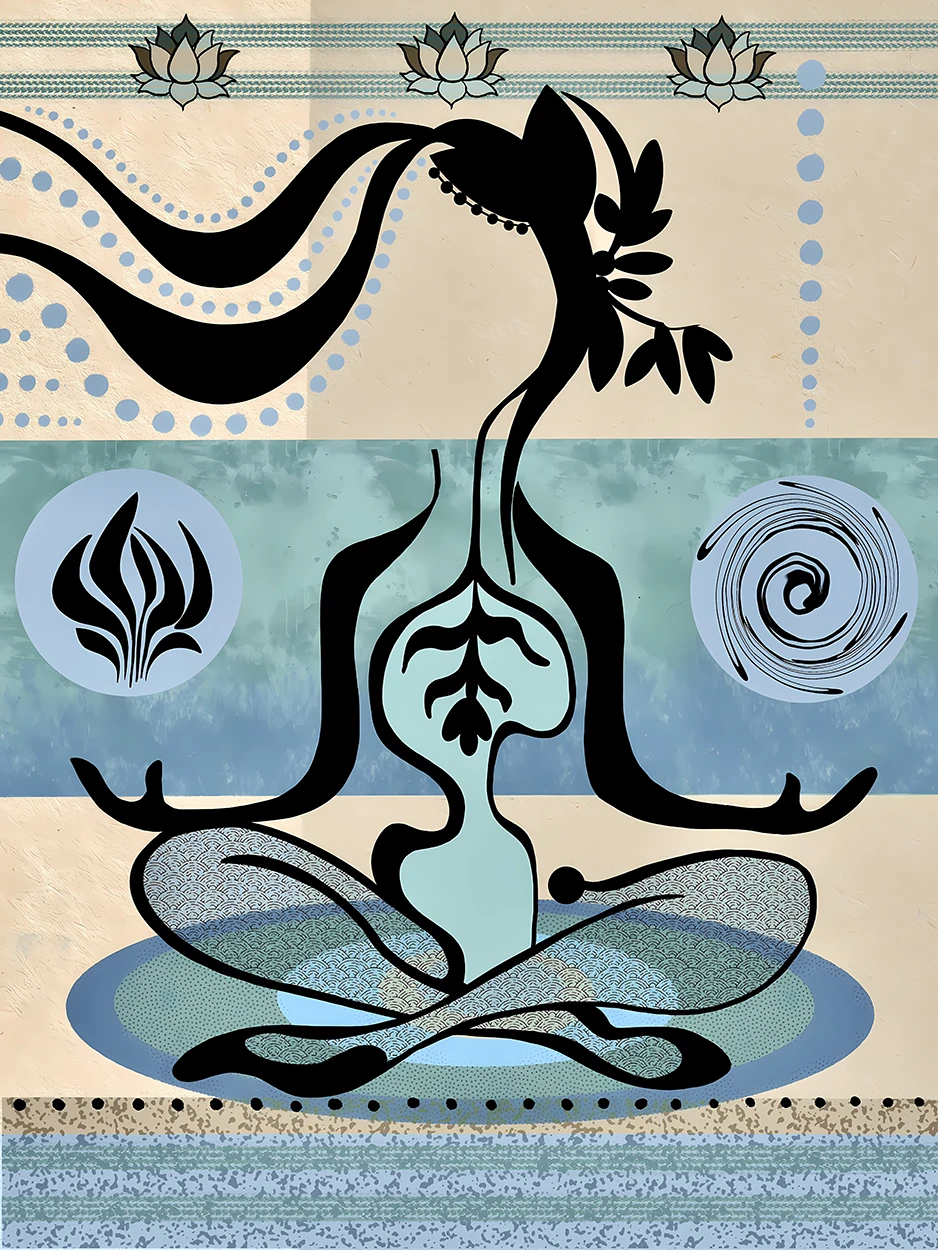Yoga and Silence
The muted blues and earthy tones evoke serenity, but the circular symbols surrounding the figure suggest deeper elemental forces at play. On one side, a flame-like shape, bold and assertive, balances the calm swirl on the opposite. These two symbols—the fire and the spiral—might represent the balance between action and surrender, energy and stillness. They are opposing yet complementary forces, much like the yin-yang dynamic in Eastern philosophy.
Look at the way the body’s inner lines branch out like the veins of a tree, connecting back to nature. It’s as if the figure is both human and more-than-human, rooted in the earth and its cycles. The leaves sprouting from the head reinforce this idea: the mind is fertile ground for growth, but only through stillness can this growth occur. There is an implied surrender to nature, to the forces of the cosmos, and yet a deep personal mastery.
The lotus flowers at the top of the composition are subtle but vital. In Eastern traditions, the lotus is a symbol of purity, of rising above the muck to bloom in beauty. Here, they seem to frame the figure, suggesting that the state of meditation and silence is not only a personal journey but a universal one, echoing through the ages.
What strikes me most about this piece is its balance of complexity and simplicity. The lines are clean, the shapes straightforward, yet each element has a hidden depth, inviting contemplation. “Yoga and Silence” isn’t just about the practice of yoga or the act of meditation; it’s about the space in between—the silence that speaks louder than words, the stillness that vibrates with potential. It’s an invitation to sit with ourselves, to explore the vast, quiet spaces within, and to grow from that silence.

This artifact boasts a resolution of 300dpi and measures 70cm (27.5in) on its longest side. It is an excellent way to showcase your style and personality on your wall, adding character to your space. It makes for a unique and lasting gift. Printing at these dimensions will result in high-quality prints. Doubling the dimensions will allow for larger prints suitable for interior decoration. We have provided some artifact sizes based human size to give you an idea.
Looking to purchase art from our online gallery? Follow these simple steps:
- Find the artwork you love and click on it. If you're considering multiple pieces, click "ADD TO CART." If you've decided on just one, click "BUY NOW."
- Feel free to keep browsing our gallery and adding more artwork to your cart.
- To review your selected artworks, click on the shopping cart icon in the top right corner. You can remove any items if you change your mind.
- When you're ready to complete your order, click "CHECKOUT" at the top right corner of the screen.
- After your purchase, you'll receive a download link. Additionally, we'll send the link to your email address for easy access.
Wondering how to pay for your selected artworks? Here's how:
Simply click the "CHECKOUT" button to finalize your order, and then select your preferred payment method. We offer the following options:
- Credit cards (Stripe)
- PayPal
- Bank transfer (Upon placing your order, we'll send you an invoice. Once the invoice is paid in full, we'll proceed to ship the artwork.)
Is the payment secure?
- Rest assured, our payment system is highly secure. We exclusively process transactions that are 3D secured to combat fraud.
- Additionally, as an added measure of protection, we may request identity verification to prevent unauthorized use of your credit card.
Is it possible to request a commissioned artwork with specific size and color preferences?
- Interested in commissioning an artwork of a specific size or color? While not all artists offer commissions for paintings and sculptures, you can request a customized size print.
- Feel free to reach out to us and share your requirements if you're interested in commissioning an artwork. We're here to assist you.
Shipping & Returns?
Purchase Terms of Agreement
The purchase of digital products, including EPS, PDF, AI or JPG downloads and online material is subject to the following terms and conditions. Consumers are advised to review carefully before making any purchase
Payment + Refund Policy
All transactions for purchase of intangible products, pdf, eps, ai or jpg downloads, resource material, and online content are made through payment gateways such as PayPal or Stripe that use SSL encryption. These payment gateways are safe and secure for using all types of credit cards and debit cards in different countries and your details are not stored during this process.
Since your purchase is a digital product, it is deemed “used” after download or opening, and all purchases made on www.daymara.com (Swiss Llc Ltd.) are non-refundable or exchangeable. However, we will provide a full refund if the resolution, print quality, if you have received a product that differs from the product image shown to you at the time of purchase or if there are file errors. Since the products made available here are intangible, there is a strict no refund policy.
Daymara (Swiss Llc Ltd.) reserves the right to amend any information, including but not limited to prices, technical specifications, terms of purchase and product or service offerings without prior notice.
Delivery of Goods and Services
If you do not receive the digital product link upon purchasing, you can immediately contact [email protected] with your transaction/payment details to ensure your product is delivered as soon as possible.
Delivery Process
- The product you purchased is a print-ready visual design product.
- A download link of the product will be presented to you after the purchase. You will be able to download and use the work using this link.
- Delivery is provided with a downloadable link after purchase. Also, no physical product will be sent. Please make sure you understand this point. If you have any questions, please write to us from the contact section.
- Each product may be in different sizes. The maximum printable size of the product is written on the page of the product. It is naturally possible to print larger than this size. But in this case, pixel distortions can be seen.
- Since a downloadable link is offered to you after purchasing the product, the product you have purchased is deemed to have been delivered.
- It is not possible to return the delivered products or cancel the order after this stage. However, we will provide a full refund if the resolution, print quality, if you have received a product that differs from the product image shown to you at the time of purchase or if there are file errors.
- If you encounter a problem with the file you downloaded, please do not hesitate to contact us. Your request will be answered within 1 hour at the latest.




 70-140cm (27.5″≈55″) Printable
70-140cm (27.5″≈55″) Printable

